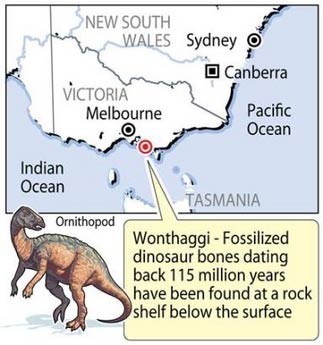The discovery of dinosaur fossils hindered Australia's term plan
A desalination project to help Australia's second largest city escape a $ 2.7 billion drought is likely to be postponed when dinosaur bones are discovered near the project site. construction ants.
This fossil is estimated at 115 million years old, the bones of dinosaurs and ancient marine reptiles. Fossils are found on a windy sand bank near the Powlett River, southeast of Melbourne and right in front of the project's expected location.
Ken Smith, a local legislator, said in an interview with Reuters that the area must be studied before the project can be implemented.'If you continue to build, it is like people drilling into ancient Egyptian tombs or Chinese clay warriors after discovering it. This area has archaeological values for this region and the whole world. '
Many places in Australia have suffered from drought for more than a decade and environmental scientists warn the drought may be due to global warming.
The city of Melbourne plans to build one of the world's largest desalination plants to combat drought in the city. The plan is scheduled to start next year and in 2011, the city will be provided with 150 billion liters of fresh water each year. Israel also has a similar construction plan. This plant will separate salt from seawater by reverse osmosis. Then, salts are returned to the ocean and pumped purified water through 85-kilometer long pipes into the city.

Location of fossil dinosaur bones found: southeast of Melbourne city (Photo: Reuters)
Some local newspapers cite Lesley Kool, Monash University dinosaur researcher: these fossils include teeth, bones and vertebrae. She said that the stone in this area was formed during the Australian period still in the polar region.
Other fossils include the teeth of the Pleisosaurs - a small reptile, long neck that lives in the water and of Qantassaurus grass-eating dinosaurs.
Tim Holding, director of Victoria's Water Resources Department, has yet to release a report regarding the environmental impact of the archaeological site. A spokesman for the Department said: 'We will carefully consider environmental and cultural issues before making a final decision.'
- China has discovered unprecedented dinosaur fossils
- Discover dinosaurs 'armored' never known
- 110 million year old dinosaur fossils
- The dinosaur fossil is about the size of a chicken
- Shocking discovery of dinosaurs drive and
- Repeatedly discovered dinosaur fossils in Canada
- Detecting the first individual cavities dinosaurs
- Finding fossil dinosaur eggs in Argentina
- 70 million year old dinosaur fossils
- Close up of the world's largest dinosaur park
- Can the gender of dinosaur fossils be determined?
- Detecting tyrannical dinosaurs with beautiful feathers
 Discovered an ancient centipede fossil 99 million years old
Discovered an ancient centipede fossil 99 million years old Discovered bat-like dinosaurs in China
Discovered bat-like dinosaurs in China Discovered a 200-year-old bronze cannon of the coast
Discovered a 200-year-old bronze cannon of the coast Discover 305 million-year-old spider fossils
Discover 305 million-year-old spider fossils